
This article relates to the flora of New Zealand, especially indigenous strains. New Zealand's geographical isolation has meant the country has developed a unique variety of native flora. However, human migration has led to the importation of many other plants as well as widespread damage to the indigenous flora, especially after the advent of European colonisation, due to the combined efforts of farmers and specialised societies dedicated to importing European plants & animals.

The Marchantiophyta are a division of non-vascular land plants commonly referred to as hepatics or liverworts. Like mosses and hornworts, they have a gametophyte-dominant life cycle, in which cells of the plant carry only a single set of genetic information.

Non-vascular plants are plants without a vascular system consisting of xylem and phloem. Instead, they may possess simpler tissues that have specialized functions for the internal transport of water.

The Tasmanian temperate rain forests are a temperate broadleaf and mixed forests ecoregion in western Tasmania. The ecoregion is part of the Australasian realm, which includes Tasmania and Australia, New Zealand, New Guinea, New Caledonia, and adjacent islands.

Buxbaumia is a genus of twelve species of moss (Bryophyta). It was first named in 1742 by Albrecht von Haller and later brought into modern botanical nomenclature in 1801 by Johann Hedwig to commemorate Johann Christian Buxbaum, a German physician and botanist who discovered the moss in 1712 at the mouth of the Volga River. The moss is microscopic for most of its existence, and plants are noticeable only after they begin to produce their reproductive structures. The asymmetrical spore capsule has a distinctive shape and structure, some features of which appear to be transitional from those in primitive mosses to most modern mosses.

Polytrichum commune is a species of moss found in many regions with high humidity and rainfall. The species can be exceptionally tall for a moss with stems often exceeding 30 cm (12 in) though rarely reaching 70 cm (27.5 in), but it is most commonly found at shorter lengths of 5 to 10 cm. It is widely distributed throughout temperate and boreal latitudes in the Northern Hemisphere and also found in Mexico, several Pacific Islands including New Zealand, and also in Australia. It typically grows in bogs, wet heathland and along forest streams.

Helodium blandowii, also known as Blandow's helodium moss, Blandow's tamarisk-moss, Blandow's bogmoss, and Blandow's feathermoss, is a rare plant in the Western U.S., including Oregon and California. It occurs all around the northern hemisphere in higher latitudes, and in some places is not as rare as in the Western U.S.
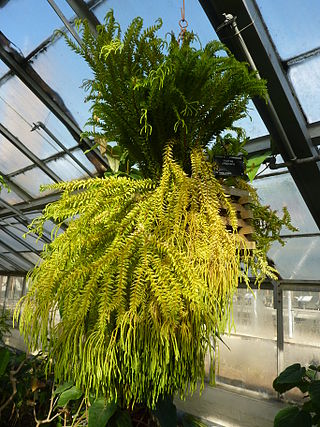
Phlegmariurus phlegmaria, synonym Huperzia phlegmaria, commonly known as either coarse tassel fern or common tassel fern, is an epiphytic species native to rainforests in Madagascar, some islands in the Indian Ocean, Asia, Australasia and many Pacific Islands. Phlegmariurus phlegmaria is commonly found in moist forests and rainforests at high altitudes, in and amongst mosses and other epiphytes. Members of the order Lycopodiales are commonly referred to as clubmosses.
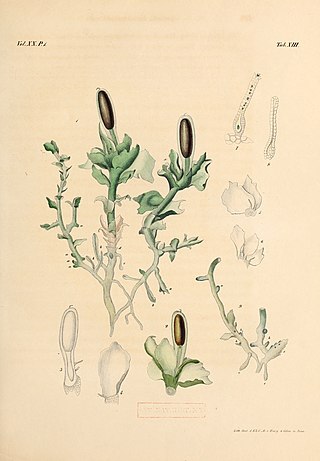
Haplomitriopsida is a newly recognized class of liverworts comprising fifteen species in three genera. Recent cladistic analyses of nuclear, mitochondrial, and plastid gene sequences place this monophyletic group as the basal sister group to all other liverworts. The group thus provides a unique insight into the early evolution of liverworts in particular and of land plants in general.
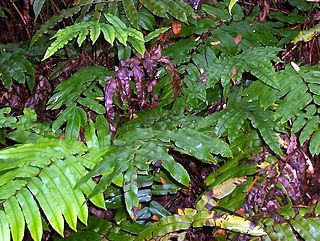
Parablechnum wattsii, synonym Blechnum wattsii, is a common terrestrial fern growing in rainforest and open forest. It is often seen near creeks in much of south eastern Australia, including Victoria, Tasmania, South Australia, New South Wales and Queensland. The specific epithet wattsii honours William Walter Watts (1856-1920). Watts was considered an authority on mosses and ferns and has more than 30 species named for him. Common names by which the species may be called are hard water fern - from its stiff leathery fronds, leech fern - as forest workers often encounter leaches while working in clusters of these ferns, hard hill fern - from the fern's habit and habitat, and red cabbage fern - from the bronze-pink colour of the young fronds resembling cooked red cabbage.

Rhytidiadelphus squarrosus is a species of moss known as springy turf-moss in the United Kingdom, and square goose neck moss in the United States. It is widespread in Eurasia and North America, and has been introduced to the Southern Hemisphere. It has broad ecological tolerances, and is usually found in man-made habitats such as lawns and golf courses. It is most closely related to R. subpinnatus, with which it is often confused.

Ptilidium is a genus of liverwort, and is the only genus in family Ptilidiaceae. It includes only three species: Ptilidium californicum, Ptilidium ciliare, and Ptilidium pulcherrimum. The genus is distributed throughout the arctic and subarctic, with disjunct populations in New Zealand and Tierra del Fuego. Molecular analysis suggests that the genus has few close relatives and diverged from other leafy liverworts early in their evolution.
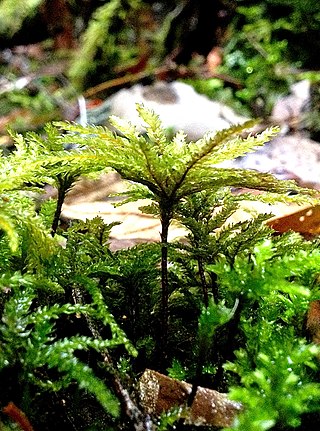
Hypnodendron comosum, commonly known as palm moss or palm tree moss, is a ground moss which can be divided into two varieties: Hypnodendron comosum var. comosum and Hypnodendron comosum var. sieberi. Both Hypnodendron varieties most commonly grow in damp locations in the temperate and tropical rainforests of New South Wales, Victoria, and Tasmania in southern Australia and in New Zealand.

Racomitrium lanuginosum is a widespread species of moss found in montane and arctic tundra, the genus Racomitrium is found across the Northern and Southern hemispheres., however Racomitrium lanuginosum is only found in the Northern hemisphere. It grows as large mats on exposed rock and in boulder scree, particularly on acidic rocks. Its leaves have a characteristically decurrent and toothed hair-point, which gives rise to its regional common names woolly fringemoss, hoary rock-moss and woolly moss.

Trichocolea mollissima is a large liverwort of the Trichocoleaceae family. It is found commonly throughout wet sclerophyll and rainforests in Australia and New Zealand. In Australia it is present in Tasmania, Victoria, New South Wales and Queensland. It also occurs extensively on the north island of New Zealand. Its most distinctive feature is its highly divided, densely arranged and extremely small leaves, which lend it a woolly appearance; hence its common name “woolly worm”. It usually grows in a matted or tufted habit on the ground and lower trunks of trees, and exhibits a preference for decaying wood and deep shade. On casual observance, its leaf arrangement and growth habit resemble that of a large moss. Its stems are commonly 3–6 cm long, with leaves up to 0.6mm wide, with up to 3-3 divisions. leaves and stems are arranged in bi-pinnate form. It is commonly coloured pale-yellow-green, which fades to white or blue-green upon desiccation in drier conditions.
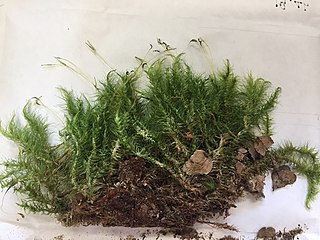
Dicranoloma dicarpum is relatively common moss which is widespread in the Southern Hemisphere. The genus Dicranoloma has 40 species, which share the features of long stems, wispy and twisted leaves, and large, erect capsules. The genus is dominant in wet forest habitats in Australia and New Zealand.
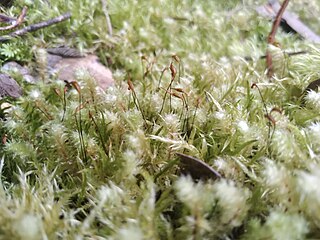
Ptychominon aciculare is a species of moss found predominantly in Australia, New Zealand, New Caledonia, Samoa, Juan Fernandez Islands and Chile. It is easily recognised given its similarity, especially when partially dried, to a pipe-cleaner. This name is commonly accepted across Australia and New Zealand. It has been observed growing from between sea level to sub-alpine altitudes (1200m).
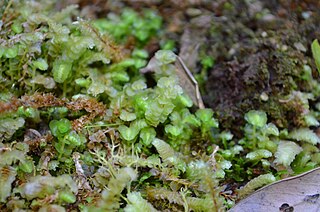
Tylimanthus pseudosaccatus is a bryophyte, a species from the liverwort family Acrobolbaceae. The family grows on logs, rocks, and soil. Under certain circumstances, however, they are epiphyte, growing on other plant species.

Polytrichastrum formosum, commonly known as the bank haircap moss, is a species of moss belonging to the family Polytrichaceae.

Symphyogyna podophylla is a dendroid liverwort which is widespread in wet forests. It occurs in New Zealand, South America, Southern Africa, and is very common in wet forests of Australia and Tasmania.




















